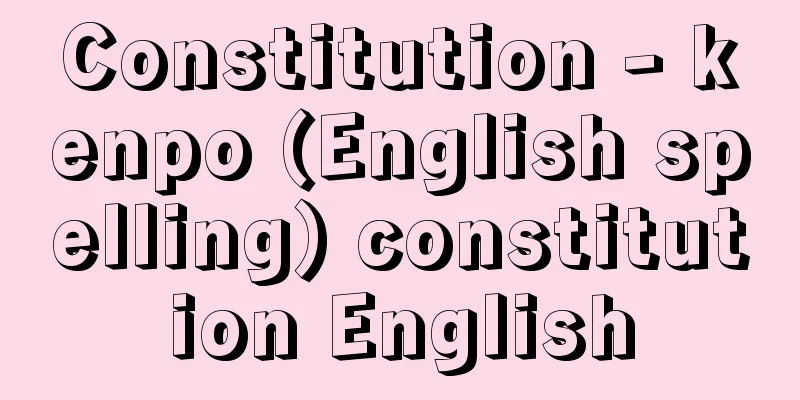Constitution - kenpo (English spelling) constitution English

OverviewGenerally, it refers to a modern constitution in the constitutional sense, but it is also used in various other senses. First, it is used to refer to the entire body of law that determines the basis of a state's governing system, that is, fundamental law (basic law). In any primitive state, where there is a power order, there are certain agreements regarding the relationship between the rulers and the governed, the scope of rule, the method of rule, etc., and this is called a "constitution in the inherent sense." In this case, the constitution is not necessarily codified, but is often established as a customary norm inherent in the de facto relationship of rule. In contrast, in the early modern period, when fundamental laws containing certain political principles were established based on the demands of political liberalism in order to restrict various forms of despotism, especially the despotic power of the monarch, this came to be called a constitution. A constitution in this sense is called a "constitution in the constitutional sense." While a constitution in the proper sense refers to the essential meaning of a constitution, this refers to its historical meaning, and is also called a "constitution in the modern sense." The constitution referred to in Article 16 of the French Declaration of the Rights of Man and of the Citizen (1789) is an example of this. When we say "Constitution of Japan," if we are referring to a constitution in the proper sense, it means the organizational laws of the various governing systems that began with the founding of the country, but if we are referring to a constitution in the constitutional sense, it was first established with the Constitution of the Empire of Japan (Meiji Constitution). Usually, when we simply say "Constitution," we are referring to a constitution in the constitutional sense. Next, when referring to a special legal form such as a constitutional code, it is called a "constitution in the formal sense," whereas when referring to laws generally related to the foundations of the organization and function of the state, it is called a "constitution in the substantive sense." The Diet Act of Japan is a law that relates to the basic organization of the country, so it is included in the substantive sense of constitution. In this kind of distinction, it is not wrong to think that when we say "Constitution," we are generally referring to a constitution in the formal sense (Constitutional Code). The word "kenpo" (constitution) was first found in Prince Shotoku's Seventeen-Article Constitution, but this differs from what we now call constitutions, and has a strong moral character for the government and the people. When the concept of constitution in the constitutional sense was introduced from the West from the end of the Edo period through the Meiji period, the characters "kokuken" were used as a translation of the English and French "constitution" and the German "Verfassung," but in the 1870s it came to be called "kenpo," and eventually became definitive. [Masaaki Ikeda] ClassificationConstitutions are classified as follows based on their legal form, amendment procedure, subject and method of enactment, and historical content (social system). [Masaaki Ikeda] Written and unwritten constitutionsThe distinction between written and unwritten constitutions is a classification based on the form of law, but the only country that still exists with an unwritten constitution is the United Kingdom. Even then, constitutional regulations have been codified, albeit fragmentarily, through acts such as the Habeas Corpus Act (1679), the Act of Succession to the Throne (1701), and the Act of Parliament (1911), so saying that "the United Kingdom has no constitution" is merely emphasizing the fact that the United Kingdom does not have a written constitutional code like other modern nations have. In other words, a written constitution, especially a constitutional code, is called a "constitution in the formal sense," and if the entire basic law of a nation, whether written (in the form of laws and regulations) or unwritten (customary law, etc.), is called a "constitution in the substantive sense," then what the United Kingdom does not have is a constitution in the formal sense. Written constitutions are common in modern nations. This is because even in the case of a constitution in the proper sense, it is believed that since it is the basic order of the nation, it must be secured in some way, and this idea is even stronger in the case of a constitutional constitution, which was codified in order to fix the new political and social principles. In other words, written constitutions have developed to meet the demand for establishing new systems when political and social reforms are made by discarding the old system, and historical examples of this have appeared accordingly. For example, the appearance of the first written constitutions, such as the Virginia Constitution of 1776 (United States of America) and the French Constitution of 1791, can be seen in relation to their historical background. [Masaaki Ikeda] Rigid Constitution/Flexible ConstitutionThe need to fix political and social principles creates a demand to make a written constitution as difficult to change as possible once it has been created, and strict requirements and procedures are set for its amendment. In terms of amendment procedures, a constitution that cannot be amended through normal legislative procedures is called a "rigid constitution." In contrast, a constitution that can be amended without going through such strict amendment procedures is called a "flexible constitution," of which there are only a few examples, such as the New Zealand Constitution, the French Constitution of 1814, and the Italian Constitution of 1848. Flexible constitutions are easily amended, so they are often thought to lack stability, but this is not necessarily the case. Even in the case of rigid constitutions, there are cases where they have been amended and revised many times, as can be seen in the examples of the Swiss, Norwegian, and American constitutions. In the case of rigid constitutions, democratic constitutions tend to require public participation (through amendment proposals, referendums, etc.) in order to more actively involve the people as sovereigns. Rigid constitutions have the effect of preventing them from being changed thoughtlessly through casual policy considerations, but on the other hand, if the amendment procedures are too strict, they will have defects such as being unable to respond promptly to the will of the people in the future, which could lead to the constitution being ignored or destroyed. If this is not the case, "constitutional evolution" will occur, in which the interpretation of provisions changes within the constitutional framework. The reason why the United States Constitution has survived so long despite its rigidity is that the constitution has evolved through interpretation by the courts. [Masaaki Ikeda] Imperial Constitution, Civil Constitution, Convention Constitution, Treaty ConstitutionA constitution that is enacted by the monarch and is given from above based on the idea of monarchical sovereignty is called an imperial constitution. In contrast, a constitution that is enacted by the people directly or through a parliament is called a civil constitution. Examples of the former include the French Constitution of 1814 and the Constitution of the Empire of Japan, while examples of the latter include the constitutions of the United States of America, the French constitutions of 1791, 1946, and 1958, and many other republican constitutions. Next, a constitution that is established by agreement or contract between the sovereign monarch and the people (the people) is called a conciliatory constitution. A typical example is the French Constitution of 1830. A treaty constitution is a constitution that is established based on the agreement of multiple nations that join together to form a federation. Typical examples include the United States Constitution and the 1871 Imperial German Constitution. However, these distinctions based on the body of enactment or the method of enactment do not indicate the substantive nature of each constitution, so such formal classifications no longer have much importance today. [Masaaki Ikeda] Capitalist Constitution/Socialist ConstitutionInstead of the traditional classification mentioned above, a classification method that is far more important in modern times is the classification based on the difference in social and economic systems, that is, the distinction between capitalist constitutions and socialist constitutions. Furthermore, in the case of capitalist constitutions, unlike the systems of free states based on the laissez-faire economic policy of the past, many modern capitalist constitutions are based on the systems of social states based on state intervention in the economy, and constitutions under the former systems of free states are called modern constitutions or civil constitutions, while the latter are called contemporary constitutions. Nevertheless, they are still distinct from socialist constitutions, and there are striking differences between the two, such as the separation of powers or the concentration of power, and the way in which human rights are protected. [Masaaki Ikeda] New classificationRecently, one classification method that has been widely cited is the "ontological classification" proposed by Karl Loewenstein (1891-1973). According to this classification, modern written constitutions are divided into three categories: normative constitutions, nominal constitutions, and semantic constitutions. Normative constitutions are those that actually function as political norms, and many constitutions in Western countries belong to this category. Nominal constitutions are those that do not actually fulfill the role of norms, and there are many examples of this in Latin America. Semantic constitutions are those that merely formalize the rule of powerful rulers, and examples include constitutions in Asian and African countries. Although the above classification has the disadvantage of leaving room for subjective value judgments to intervene, it is considered noteworthy in that it focuses on the social function of the constitution. [Masaaki Ikeda] Characteristics of the ConstitutionBecause the Constitution is the fundamental law of the nation, it has a unique character that is different from ordinary laws. As long as law is created through a political process, it can be said that law is the child of politics, but the Constitution is a particularly political law. This is because not only are the establishment of the Constitution and political upheaval themselves political, but also because policy decisions are made within the framework of the Constitution by integrating political conflicts, even within the framework of a peaceful and stable order, and are closely related to the lives of the people. This political nature of the Constitution means that it is closely related to the relationship of power, but on the other hand, the Constitution, as the highest law, has the power to discipline real politics. In other words, the Constitution specifies the important organizations of the nation and how they are to be operated, and provides a certain direction so that national affairs are conducted based on these basic rules. In this sense, the Constitution is essentially normative as a law. In this way, the Constitution is both political and normative, existing as a synthesis of both. The following three points can be cited as characteristics of the normative nature of the Constitution. [Masaaki Ikeda] The Constitution as an Enabling NormSince a constitution in the substantive sense regulates the legislative procedures and the content of laws, it can be said that all laws exist directly or indirectly based on the authorization of the constitution. Hans Kelsen (1881-1973) was the first to consider this relationship between authorization and acceptance in stages, and proposed the theory of legal stages, which is "constitution-law-command." [Masaaki Ikeda] The Constitution as a restrictive normA constitution in the constitutional sense has as its main pillars the separation of powers and the protection of rights, so it can be said that its essential aim is to limit state power. Modern constitutionalism was based on the idea of a free state = passive state, which excluded the state from interfering in the lives of its citizens, but especially after World War II, in order to realize social welfare, the state began to intervene in the economy and touch the lives of its citizens, and this gave rise to the system of a social state = active state. In this state, administrative power was expanded and strengthened, and the function of the constitution as a restrictive norm was forced to undergo a significant transformation. [Masaaki Ikeda] The Constitution as the Supreme NormA constitution in the formal sense usually has a special legal form as a constitutional code and is based on rigid constitutionalism. Therefore, it has a stronger formal effect than ordinary laws. Thus, the constitution inevitably has the character of the supreme law. The Constitution of Japan dedicates Chapter 10 to the "supreme law," stipulating that it has the strongest formal effect and that any laws that violate it will have no effect. The system that effectively ensures that the constitution is the supreme law is the system of constitutional review. [Masaaki Ikeda] Principles of a Modern ConstitutionThe question is what kind of direction the constitution, especially modern constitutions, give to national politics. The following are some of the important principles related to the constitution: First, there is the principle of national political participation, or popular sovereignty. Although it would be ideal for all citizens to directly participate in politics, this is not possible, so in many countries, citizens have indirect political participation, i.e. indirect democracy. Next, there is the principle of separation of powers. Although its specific form varies, the reason for the existence of constitutions in the modern sense is that they have this principle in some form. Then there is the principle of freedom, which sets the limits on the exercise of state power. In other words, it is the principle of protecting fundamental human rights. The importance of this principle can be understood from the fact that Article 16 of the French Declaration of the Rights of Man (1789) already lists it as one of the two major components of constitutions, alongside the principle of separation of powers. Finally, there is the principle of the rule of law, or rule of law. This is the idea of the superiority of law over the executive. This principle, based on the constitution's supreme law status, gave rise to a system of judicial review of unconstitutional legislation. It should not be forgotten that these principles have changed with the changing historical conditions. For example, because indirect democracy is prone to deviating from the will of the people, various direct democratic systems have been introduced to realise national sovereignty, and there are warnings that the balance between the three branches of powers is being lost due to the expansion and strengthening of administrative power, and various measures to restore this balance are being sought. In fact, the principle of freedom is in a situation where the state's intervention in people's lives has become so widespread that there are fears that the country will become a managerial state. On the other hand, we must also pay attention to the emergence of constitutions with completely different principles, such as the emergence of socialist constitutions, beginning with the Soviet Constitution (1918). These constitutions are based on social conditions different from those of the traditional civil society order, and so they must be understood as belonging to a different category from constitutions in the modern sense. [Masaaki Ikeda] Constitutional ChangesA constitution is the fundamental law of a nation, and is enacted with the expectation that it will be permanent. It is never desirable to change it, but when major changes in social circumstances or systemic inconveniences arise, constitutional changes can occur. According to Carl Schmitt, there are five types of constitutional changes: constitutional abolition, constitutional elimination, constitutional destruction, constitutional suspension, and constitutional amendment. Constitutional abolition is a phenomenon seen during revolutions, and refers to changes accompanied by the removal of the power to create a constitution. Constitutional elimination is a phenomenon seen during coups, and refers to the removal of the constitution while leaving the power to create a constitution intact. Constitutional destruction is the violation of some constitutional provisions, and constitutional suspension is a phenomenon seen during national emergencies such as martial law, and refers to the temporary suspension of some constitutional provisions. The concept of constitutional change proposed by Jelinek has also been the subject of debate. [Masaaki Ikeda] Constitutional amendmentA constitutional amendment is a legal change that amends, deletes or adds to constitutional clauses, or supplements the original constitutional text, based on the procedures established by the constitution. There are three main methods of constitutional amendment around the world: those that require a special majority vote in the parliament, those that require approval by national referendum, and those that require the consent of the states, which is unique to federal states. The Constitution of Japan requires two requirements: a special majority vote in the parliament and approval by national referendum, making it an extremely difficult constitution to amend, with its strict requirements. This is one of the reasons why Japan has little experience in amending its constitution compared to other countries. Although the constitution is generally and abstractly defined and is designed to be able to withstand normal social changes, it may need to be amended to meet real-world demands. At such times, constitutional amendment becomes an issue. However, since constitutional amendment is something that the constitution itself allows, it is natural that amendments that would change the essence of the constitution itself cannot be made, and some countries even state this in their constitutions. This is called the limit of amendment, and the extent of the limit is said to be determined by the basic principles of the constitution. In other words, if the basic principles are changed, it is considered to have the same effect as denying the constitution, so it is correct to say that changing the basic principles is not permitted. For example, in the case of the Japanese Constitution, it can be said that amendments that would destroy the essence of its basic principles of popular sovereignty, permanent pacifism, and respect for fundamental human rights cannot be made. There is also a strong theory that the procedure for amending the constitution cannot be amended. [Masaaki Ikeda] Constitutional ChangesConstitutional change refers to changing the meaning of constitutional clauses through interpretation. The constitutional clauses remain the same, but the meaning changes, achieving the same results as constitutional amendments. Constitutional change occurs, for example, when a national organ such as the Diet, the government, or the courts interprets something, or when something contrary to the provisions of the constitution is actually carried out, and in either case it is approved without any arguments against it. One issue that is being discussed in Japan regarding constitutional change is the theory of the change in Article 9 of the constitution. This theory holds that the reason the Self-Defense Forces exist despite the provision on not maintaining military forces (Article 9, paragraph 2) is because the clause in question has been changed, but this is still held by only a minority. [Masaaki Ikeda] Constitutional GuaranteesThe violation of the provisions of the Constitution, which is the supreme law, or the change in its meaning and content brings about greater legal instability than anything else. Such things must be prevented in advance and corrected afterwards. This measure is called constitutional guarantee. Preventive guarantee systems for the Constitution include the declaration of the supreme law, the declaration of the obligation to uphold the Constitution, the adoption of a separation of powers, and the adoption of a rigid constitution. Corrective guarantees are classified into three types: those by the Court of Justice, those by the Constitutional Court, and those by national institutions such as the Constitutional Council. Those by the Court of Justice are carried out in specific legal disputes and are called the constitutional review system. These were established by precedents of the Supreme Court of the United States and are called the American type. Japan belongs to this type. Those by the Constitutional Court review the constitutionality of laws in an abstract manner, even if there is no specific legal dispute. These are established in the current German and Italian constitutions, and are called the German type. There are also countries in which political institutions other than the courts review the constitutionality of laws, one example being the Constitutional Council of France. [Masaaki Ikeda] World ConstitutionsGenerally speaking, the word "constitution" refers to the constitution of a modern state that emerged after the Civil Revolution. This constitution is characterized by expressing in written form popular sovereignty, basic human rights including economic freedom, and the separation of powers (though the UK does not have a constitution, it systematizes the actual situation of the UK's political organization and the protection of rights that have been established as custom, and calls it the UK Constitution). Incidentally, the French Declaration of the Rights of Man and of the Citizen of 1789, which is considered the starting point of modern constitutions, declares popular sovereignty in Article 3, stating that "all sovereignty is essentially derived from the people," and declares in Article 16 that "any society in which the guarantee of rights is not ensured and the separation of powers is not provided for has no constitution." These are all due to the fact that the guarantee of civil liberties, the elimination of the centralization of power as in the Ancien Régime (old system), and the guarantee of political participation by citizens, albeit with limitations, were deemed indispensable with the establishment and development of civil society. However, such modern constitutions were forced to be fundamentally revised due to structural changes in the capitalist economy, especially the development towards monopoly capitalism in the 20th century. First, modern human rights (personal freedom, mental freedom, political freedom, etc.) based on property rights (ownership, freedom of contract, freedom of business) were subject to certain revisions, while at the same time, rights to life, education, and social security, which were not found in modern human rights and were based on the right to work, appeared and expanded. Secondly, regarding the governing institutions, the parliamentary system was weakened and executive power was expanded and strengthened. This is particularly evident in the strengthening of administrative power and the expansion of institutions (bureaucracy, police). Furthermore, while judicial power was a means of relief for individuals based on the constitutional principles of modern constitutionalism, today it recognizes the power of the Constitutional Court or the Supreme Court to review unconstitutional ordinances (legislation), and plays the role of guardian of the constitution to prevent the abuse of administrative power and protect the guarantee of human rights. However, in opposition to this trend in modern constitutions, there was a demand for human liberation for the working class, which was based on the capitalist mode of production that pursues private profit, and which was the background to modern constitutions, and this demand led to the Russian Revolution, the establishment of Soviet Russia in 1917, and the establishment of the Soviet Constitution in 1924. Moreover, after the Second World War, Asian, African, and Latin American countries also escaped from colonial rule and enacted modern constitutions as independent sovereign states. The above-mentioned genealogy can be organized as follows based on social structures: [1] Constitutions of Major Countries Under Capitalist Systems Constitutions of Major Countries Under Capitalist SystemsBritish Constitution Unlike other countries, the UK does not have a unified written constitution. Therefore, in the case of the UK, it is necessary to clearly define the constitutional principles known as the Constitution. The traditionally established characteristics of the UK Constitution include parliamentary sovereignty, the rule of law, and constitutional conventions. The development of this Constitution in the 21st century can be summarized as follows: (1) Reform of the national structure and decentralization The Blair Labour government, which came to power in 1997, enacted a law in 1998 to establish devolved assemblies for Scotland and Wales. This meant that Scotland and Wales had primary legislative powers other than those reserved for the UK Parliament, and laws enacted by the devolved assemblies took precedence over Acts of Parliament. If a dispute over authority arises between the devolved assemblies and the UK Parliament, the matter is decided by the courts. (2) Enactment of the Human Rights Act The European Convention on Human Rights, which the UK ratified in 1950, allowed citizens to sue the UK government at the European Court of Human Rights if their rights were violated, and this led to an awareness of the importance of protecting human rights. In the 1980s, discussions on the enactment of a "New Bill of Rights" arose, which led to a movement to domesticate human rights protection. This led to the enactment of the Human Rights Act in 1998. The Human Rights Act contains 22 articles, and what is particularly noteworthy is that the court has the power to determine in a lawsuit whether a primary legislative provision complies with the rights under the European Convention on Human Rights, and if it is established that the provision is not in accordance with the rights, it can make a declaration of unlawfulness (Article 4, Paragraphs 1 and 2). If the subject of this declaration is an Act enacted by Parliament, the effect of the said Act will not be excluded, but if there are "compelling" reasons, the Minister has the power to amend the said Act by order. (3) Reform of the House of Lords and the establishment of the Supreme Court The 1999 amendment to the House of Lords Act stripped hereditary peers of their seats. As a result, the House of Lords was composed of 92 hereditary peers and 26 clerical peers who remained on a provisional basis, and all others were members appointed by the Prime Minister. In 2003, the Department of Constitutional Affairs (which became the Department of Justice) was established to take over the abolished Lord Chancellor's Office, the Scotland Office, and the Wales Office. In 2005, the judicial functions of the House of Lords were abolished, the concurrent roles of the Lord Chancellor and the President of the House of Lords, who were involved in all three branches of power, were abolished, the method of appointing judges was reformed, and the Supreme Court was established in 2009. Furthermore, the relationship between the House of Commons and the Cabinet has remained the same to this day, with the Cabinet, and particularly the Prime Minister, being given greater priority and power over the House of Commons. [Yoshiaki Yoshida] United States ConstitutionIn America, the United States Constitution was established in 1787 based on the Declaration of Independence of 1776. Its characteristics are, first, that it is based on the premise of popular sovereignty, and that politics are conducted under a form of "government" entrusted by the people. Second, it adopts federalism, which divides political power between the federal government and the states. Third, it adopts a presidential system (strict separation of powers). The relationship of this presidential system with Congress changed from a weak presidential system to a strong presidential system in the 1930s. Fourth, Congress is bicameral, with a Senate and a House of Representatives. Fifth, the idea of the "rule of law" is established in the form of judicial supremacy. In other words, it establishes the power of the judiciary to review unconstitutional legislation. The protection of fundamental human rights consists of the Bill of Rights and the 14th Amendment, and as it is said that "the history of freedom in America is, in no small part, a history of procedures," procedural protections are given the most importance. That is, firstly, more than half of the provisions in Amendments 1 to 10, which were added as the Bill of Rights, are procedural provisions to ensure fairness. Secondly, the Bill of Rights was established separately between the federal government and the states, and the two were unrelated, but since the 14th Amendment was enacted, this clause has allowed the Supreme Court to rule that insufficient human rights provisions are unconstitutional if a state does not adequately protect human rights. The law also provides strong protection in terms of the substance of rights protection. However, it can be noted that the content of these rights has changed significantly between before and after World War I. In particular, from the perspective of prioritizing the protection of property rights, courts have issued decisions that emphasize the protection of freedom of expression, and have sought to protect the weak. With regard to equality, the principle of "separate but equal" seen in racial issues has been discarded, and decisions have demonstrated the guarantee of true equality. Other important issues that have been a concern in the Supreme Court in recent years include (1) issues relating to privacy rights, such as abortion, euthanasia, and homosexuality, (2) the implementation of active measures to eliminate gender discrimination, the probability of special measures to consider race in choosing university admissions (preferential treatment to minorities such as blacks and Hispanics), (3) the prohibition of religious expression in public schools and the establishment of national education, public support for tuition fees for private schools, including religious ties, and (4) the issue of information collection and personal privacy carried out by the government for national security following the 2001 terrorist attacks in the United States. [Yoshida Yoshiaki] Constitutional Law of the Fifth Republic of FranceIn France under the Fourth Republic, the Algerian rebellion opposed to imperialist colonial policies worsened, and the corresponding stagnation and paralysis of the functions of the government and parliament caused, and the people urged De Gaulle to return to politics, with all their efforts to General De Gaulle, and his return (1958) was the enactment of the Fifth Republic Constitution. になったんです。 English: The first thing you can do is to find the best one to do. However, from the 1970s onwards, the Constitutional Council reviewed the law from the perspective of human rights security, gaining support from the public, and amended the constitution to grant the right to file a lawsuit against the Constitutional Council, signed by 60 members of each House of Representatives (Article 61, Paragraph 2 of the Constitution). This allowed minority lawmakers to file lawsuits against the Constitutional Council, making it an institution that was useful for balance of political forces and also had important implications for human rights security. The preamble to the current constitution declares the loyalty of the people to the rights and obligations stipulated in the 1789 Human Rights Declaration and Supplementary Preamble to the 1946 Constitution, and the loyalty of the people to the rights and obligations stipulated in the 2004 Environmental Charter. However, that was not enough, and the legal effect of the current constitution was questioned. As if to respond to this, the Constitutional Court began reviewing laws based on the human rights documents mentioned in the preamble, and it is now understood that it has constitutional effect. It is also understood that the Environmental Charter, introduced in the preamble in the 2005 Constitutional amendment, is similarly understood to have constitutional effect. [Yoshida Yoshiaki] Basic Law of the Federal Republic of GermanyEast and West Germany, which split in 1949 and had conflicting relationships, achieved unification in 1990, and the "Revised Basic Law" came into effect as the constitution of unified Germany in 1994. The method for unifying East and West Germany was carried out in the form of East and West Germany joining West Germany based on the provisions of the second half of Article 23 of the "Fundamental Law of the Federal Republic of Germany" (West Germany Basic Law), which was enacted in 1949. The first feature of the Fundamental Law is that it clearly states democratic and social order in the Constitution. In other words, the Constitution states that state power comes from the people (Article 20, Paragraph 1, Paragraph 2, Paragraph 1), and that power is exercised "through individual bodies of legislation, enforcement and trial" (Article 2, Paragraph 2, Paragraph 2). As a means of selecting representatives to exercise this power, it guarantees election systems, limited public votes, national petitions, political parties and organizations, etc. In particular, the constitutional guarantees of political parties, which are considered essential for the formation of democratic wills, are attracting attention. The second feature is that the Constitution has a clause (Article 20, Paragraph 1) that is intended to provide for social states (a state whose main duties are to guarantee a human life to all citizens) (Article 20, Paragraph 1), and based on this, it provides for the right to freedom, equal rights, guarantee of ownership, matters relating to marriage, family and schools, as well as other forced deprivation of nationality, and guarantee of asylum. Needless to say, it contains detailed guarantee provisions for equal rights and freedom, but in particular, ownership is stipulated in a way that is consistent with the principles of a social state. "Land, natural resources and means of production can be transferred to public ownership or other forms of public economy, by laws governing the methods and degrees of compensation for the purposes of socialization" (Article 15, Paragraph 1). になったんです。 English: The first thing you can do is to find the best one to do. The Prime Minister, who is the center of the government, is chosen by the Federal Council based on the proposal of the President without debate (Article 63, Paragraph 1). The federal assembly can control the elected Prime Minister through the no-confidence motion, but unlike normal proceedings, the passage of this no-confidence motion is subject to strict conditions. Furthermore, the Prime Minister is responsible for determining the "government policy" (Article 65). Each minister shall independently and at his own risk within the scope of this government's policy (Article 65). In addition, the government has the authority to obtain the consent of the Federal House of Councillors on bills, budget bills, and even urgent bills, and have the power to make the President declare a legislative emergency (Article 81). Thus, strong powers intended for the stability of the government are guaranteed. Fourth, the Federal Constitutional Court was established (established in Karlsruhe in 1951). The Federal Constitutional Court is a federal court independent and independent of all other constitutional bodies (Parliament, House of Councillors, and the federal government). The judges of that court are selected by the Federal Congress and House of Councillors (Article 94). The authority of the Federal Constitutional Court is not defined as a definite authority, but it can exercise (1) constitutional disputes regarding the rights and obligations between the Federal and Land (state) and Land, (2) an abstract norm and examination of concrete norms, (3) a constitutional prosecution, and (4) an unconstitutional examination of political parties. Most of the cases pending the Constitutional Court are constitutional prosecutions, and play its role as the last guardian of the citizens' fundamental rights. Furthermore, the German Basic Law guarantees provisions regarding the constitutional order ("suffering democracy") not seen in the Weimar Constitution. For example, the contents of the Constitution state that the acts of "free democracy" (Article 18 and 21) or "groups that violate the concept of constitutional order or cooperation among the nations" (Article 9, Paragraph 2). This is understood to be a guarantee of a constitutional order rooted in the strict reflection of Weimar democracy, but unlike the tolerance of the Weimar democracy, regulations on completely opposite and incompatible democracy can sometimes be a tool to curb anti-establishment and could deny democracy itself. The amendments in 1994 clearly stated environmental protection (Article 20a), gender equality (Article 3, Paragraph 2), and disability protection (Article 3, Paragraph 3), and the provisions for asylum security for asylum and displaced persons (Article 16a). In 1998, the provisions of Article 13, which involve the inviolability of housing, were significantly changed (additions from paragraphs 4 to 6), and the introduction of a system to monitor residences suspected of a serious crime, based on the orders of judges. In addition, a clause was established to respond to the Maastricht Treaty, a basic arrangement of the European Union (EU), and in relation to that, the amendment in 2006 added provisions regarding federal and state legislative powers (Article 23). However, overseas deployments under the Wehrmacht PKO missions, etc., have not been amended and implemented using the Constitutional Court's interpretation of the Basic Law. [Yoshida Yoshiaki] Constitution of the Republic of KoreaThe current 1987 Constitution was enacted in October 1987 with the Ninth Constitutional amendment. Looking at the constitution of the constitution, it consists of a preamble, a general rule, rights and duties of the people, the Diet, the government, courts, constitutional courts, election management, local autonomy, economy, amendments to the constitution, and six supplementary provisions. To put it into words the main characteristics, first of all, in the preamble, the people of South Korea have made efforts in all areas to "become even more solidified in the mission of democratic reform and peaceful unification in the homeland," and vows to "following the basic liberal democratic order even more firmly" and "internally improve the lives of the people, and outside contribute to permanent world peace and human co-prosperity." Secondly, with this preamble, the general rule states that the public sovereignty is advocated in the general guidelines, and that the rights of the people are strengthened and expanded. In particular, since the people's freedom of human beings was strictly restricted during the military regime, the due process (legal procedures) in criminal proceedings are made more detailed. It also clearly states new rights, such as the secrets and freedom of private life (Article 17), environmental rights (Article 35, Paragraph 2), consumer rights (Article 124), and health rights (Article 36, Paragraph 3). になったんです。 English: The first thing you can do is to find the best one to do. Fourth, the establishment of a Constitutional Court. This was one of the points that attracted attention in the constitutional amendment in 1987. The reason for its establishment was to judicial control over the president and the Diet, and to relieve human rights abuses by public authority. This is understood to be the establishment of a system of hearings regarding constitutional prosecutions (Article 111). Fifth, the amendment to the Constitution is proposed at the initiative of the majority of the members of the Diet or the president (Article 128). The proposed amendment must be published and the approval of at least two-thirds of the members of the current parliament, and the passage of the amendment that has been passed must also be obtained by the majority of voters of the Diet and the approval of the majority of voters (Article 128 and Article 130). [Yoshida Yoshiaki] Constitutional laws of the countries under the socialist systemになったんです。 English: The first thing you can do is to find the best one to do. Meanwhile, the People's Republic of China is beginning to develop new developments under the socialist system. Here, I would like to focus on the People's Republic of China, particularly the 1982 Constitution. [Yoshida Yoshiaki] Constitution of the People's Republic of ChinaThe Constitution of the People's Republic of China, enacted on December 4, 1982, falls into the form of a socialist constitution. This constitution has been amended four parts as of 2010. Its contents include the Preamble, General Rules (Chapter 1), Fundamental Rights and Duties of Citizens (Chapter 2), National Organization (Chapter 3), National Flag, National Anthem, National Coat of Coat, and Capital (Chapter 4). First, in the preamble, "After the establishment of the People's Republic of China, our society has sequentially realized the transition from new democracy to socialism. Socialist reforms of means of production and private ownership have been achieved, and the system in which people exploit people have disappeared, and a socialist system has been established," and the state "confirms that it is a national nation that has been jointly created by the people of all nations," and makes full use of its efforts to maintain the joint prosperity of each nation and independent foreign policy. Regarding Taiwan, it states, "it is part of the sacred territory of the People's Republic of China. It is the sacred responsibility of the Chinese people, including Taiwan's compatriots, to accomplish the great work of unifying the homeland is the sacred responsibility of the Chinese people, including Taiwan's compatriots." In the main text, "General Code," first states that China is "a socialist state with a people's democratic dictatorship based on the Labor-Agriculture Alliance" (Article 1, paragraph 1), and states that it is not permissible to destroy this system (Article 1, paragraph 2), and that all rights belong to the people (Article 2, paragraph 1). Regarding the basis of the socialist economic system, China declares a socialist public ownership system of means of production, namely a system of ownership by the entire people and a collective ownership system by the working masses (Article 6, paragraph 1). After that, reforms were made regarding reform and opening up and the market economy, and in the process the transfer of land use rights (Article 10), protection of personal economy and private enterprises (Article 11, paragraph 2). In 1989, a socialist system was proposed that links planned economy with market adjustment, and in 1993, Deng Xiaoping argued that "capitalism also has plans, and socialism also has markets. A market economy is not the only standard that distinguishes capitalism and socialism," was accepted, and Article 15, Paragraph 1 of the Constitution stated that "the state implements a socialist market economy." Furthermore, the amendment in 1999 added a provision such as, "In the early stages of socialism, the state will maintain a fundamental economic system that develops a diverse ownership economy, and will maintain a distribution system that coexists with diverse distribution methods" (Article 6, Paragraph 2). Furthermore, the amendment in 2004 added the statements, from the viewpoint of protecting all legal work and non-working income and emphasizing contributions to socialist work, "The state will protect the private property and inheritance rights of citizens based on the provisions of the law," and "The state can expropriate or collectively secure the private property of citizens, based on the provisions of the law, due to the necessity of public interest" (Article 13, Paragraphs 2 and 3). This has been criticized as follows: "If private property becomes the basis of this system and generalizes, it is not a socialist system. China's armed forces also states, "armed power belongs to the people. Its mission is to strengthen national defense, resist invasion, defend the peaceful labor of the people, participate in the construction work of the state, and serve the people's services" (Article 29, Paragraphs 1). になったんです。 English: The first thing you can do is to find the best one to do. Regarding national organizations, the National People's Congress, consisting of elected representatives of provinces, autonomous regions, direct municipalities and military forces, the Standing Committee (legislative bodies), the permanent body of the representatives of the Congress, the State Council, the Central Military Committee, the executive body of the highest state authority, the People's Court, the people's court, and the people's prosecutors, the legal supervisory body of the state, have been established, and their duties are divided (Chapter 3, Sections 1-7). In addition, the Presidents and Vice Presidents, which were not established in the Constitutions of 1975 and 1978, have been revived in the current Constitution (Article 79, Paragraph 1). [Yoshida Yoshiaki] Constitutional laws of countries that have transitioned to the regimeConstitution of the Russian FederationThe constitutional system in the socialist era adopted the basic principles of this system: the popular sovereignty, national (all-personal) ownership, planned economy, the concentration of power based on the Soviet system and the right to self-determination of the nations. However, in reality, one-party rule of the Soviet Communist Party was established, creating an authoritarian system that created various in-system contradictions, and combined with the long economic recession, causing the social system to shake up. Gorbachev, the Soviet leader, tried to rebuild the system by setting up perestroika, but failed, and in 1991 the Soviet Union was disbanded. Russia, which was one of the constituent republics of the Soviet Union, had already started preparing to draft a new constitution in response to the new Russia, in the summer of 1990, like other constituent republics, by revising its direction to independence from the Soviet Union, and by implementing a "declaration of sovereignty," but in the power struggle between the radical reformists centered around President Yeltsin and the majority forces of parliament opposing its direction, no work was made to amend the constitution. In the end, the dissolution of Parliament and the emergency measures by Yeltsin put an end to the old system. Yeltsin held a referendum in December 1993 and adopted the draft constitution he led, and the New Russian Federation Constitution (Constitution 1993) was enacted. になったんです。 English: The first thing you can do is to find the best one to do. The governing structure consists of the President, Congress and the federal government, and is established from Articles 80 to 117. The president is the head of state (Article 80). He is elected directly by the people, and has a term of office of up to four years or two. Although there are certain restrictions, he holds strong authority (Articles 83-90). The federal parliament is a representative and legislative body of the Russian Federation, and is bicameral: the Federal Congress (Senate) and the State Congress (House of the Commonwealth). The Federal Congress is made up of two representatives, one from the representative and executive bodies of the state power of each constituent entity of the Russian Federation, while the other constituent assembly is made up of 450 members and is elected for a four-year term (Articles 95 and 96). The Congress of the State has the powers to agree to the appointment of a Prime Minister, to hold confidence and no confidence in the government, to appoint and dismiss the president of the central bank, and to impeach the president (Articles 103). The Congress of the Federal Congress has the powers (Articles 102) such as changing the boundary between the federal constituent bodies, to approve martial law and state of emergency, to approve military action abroad, to appoint a constitutional court, the Supreme Court, and the Supreme Arbitration Court, to appoint a prosecutor general, to dismiss the president after the impeachment resolution of the National Congress. The Prime Minister will be appointed by the President with the consent of the National Conference. The Prime Minister's authority is limited and exercises his enforcement rights under the direct involvement of the President. He will carry out budget preparation, fiscal and credit, implementation of monetary policy, academic, cultural, national defense and security, and maintain social order (Article 114). The Constitutional Court consists of 19 judges. The subject of constitutional conformity examination includes (1) federal laws, presidents, parliamentary and government laws, (2) constitutions, charters, statutes of constituents, (3) treaties between the Russian Federation and constituents, and (4) treaties before they enter into force. Laws that have been deemed unconstitutional by the Constitutional Court, or individual provisions thereof, are ineffective (Article 125). [Yoshida Yoshiaki] Constitutional laws of Eastern European countriesAfter World War II, Eastern Europe was characterized as a socialist constitution, or a transitional constitution that was not completed by the people's democratic constitution, or a constitution that was in transition. However, after the Soviet Union was dissolved, Eastern European countries (Bulgaria, Romania, Czech Republic, Slovakia, Hungary, Poland) were transformed into a capitalist system. Among these constitutions, we will explain the characteristics of these constitutions, mainly the Polish constitution. になったんです。 English: The first thing you can do is to find the best one to do. In a national organization, the head of state is elected directly by the people, and appoints the Prime Minister and the members of the Ministerial Council. Trials take place in two groups, the regular courts and the administrative courts, as well as the constitutional courts and the state courts. The national court council is established as an institution that protects the independence of courts and judges, and there are also independent bodies such as the Supreme Court, the Ombudsman, and the National Radio and Television Council. Citizens have clear personal, political, economic, social and cultural freedoms and rights. In particular, the relationship with the Catholic church, which most Polish citizens believe, is stipulated by a treaty of dogma and state with the state. Furthermore, regarding their relationship with the European Union (EU), which joined in 2004, the Constitutional Tribunal holds that the EU member treaty is constitutional. [Yoshida Yoshiaki] "Sato Isao, Comparative Political System" (1968, University of Tokyo Press)" ▽ "Lecture of Comparative Constitution" edited by Shimizu Nozomi (1972, Seirin Shoin-Shinsha)" ▽ "Higuchi Yoichi, Comparative Constitution" revised edition (1984, Seirin Shoin-Shinsha)" ▽ "Yoshida Yoshiaki, Theory of Constitution Modern (1985, Keibundo)" ▽ "Higuchi Yoichi, Comparative Constitution Completely revised third edition (1992, Seirin Shoten)" ▽ "Introduction to Comparative Constitution Edited by Abe Teruya (1994, Yuhikaku)" ▽ "Yoshida Yoshiaki, Revised edition (1996, Keibundo)" ▽ "Tsujimura Miyoko, Comparative Constitution" (2003, Iwanami Shoten)" ▽ "New edition of "System Constitution Dictionary" edited by Sugihara Yasuo (2008, Seirin Shoin)" ▽ "Abe Teruya and Hata Hiroyuki, "The World Constitutions" 4th Edition (2009, Yushindo Takabunsha)" ▽ "Hatsujuku Masanori and Tsujimura Miyoko, "New Commentary: World Constitutions" 2nd Edition (2010, Sanseido)" ▽ "Kobayashi Naoki, "Reading the Constitutions" (Iwanami Shinsho)" ▽ "Takahashi Kazuyuki, "New Edition" (Iwanami Bunko)" [Reference items] | | | | | | | Constitutional Court | | | | of China | | | Constitution |Source: Shogakukan Encyclopedia Nipponica About Encyclopedia Nipponica Information | Legend |
概説一般には立憲的意味の近代憲法をさすが、そのほかにもさまざまな意味に用いられる。 まず国家の統治体制の基礎を定める法の全体、すなわち根本法(基礎法)をさす場合に用いられる。いかなる原始国家であっても、権力秩序のあるところには、治める者と治められる者との関係、支配の範囲、統治の仕方などについて、一定の取決めが存在するからであって、これを「固有の意味の憲法」という。この場合、憲法はかならずしも成文化されずに、事実上の支配関係に内在する慣習的な規範として成立していることが多い。 これに対し、近世になって、政治上の自由主義的要求に基づき、さまざまな専制主義、とくに君主の専制権力に対抗して、それに制約を加えるための、一定の政治原理を含む基礎法が確立されると、これを憲法とよぶようになった。この意味の憲法を「立憲的意味の憲法」という。固有の意味の憲法が憲法の本質的意義をさしているのに対して、これは歴史的意義をさしており、「近代的意味の憲法」ともいう。フランス人権宣言(1789)第16条でいう憲法はこの例である。 日本の憲法という場合に、それが固有の意味の憲法をさしているならば、建国とともに始まるいくつかの統治体制の組織法を意味するが、立憲的意味の憲法をさしているならば、それは大日本帝国憲法(明治憲法)によって初めて成立したということになる。通常、単に憲法というときは、立憲的意味の憲法をさしている。次に、憲法典という特別の法形式のものをさすときは「形式的意味の憲法」といい、これに対し、国家の組織・作用の基礎に関する法一般をさすときは「実質的意味の憲法」という。わが国の国会法などは国の基礎的組織にかかわる法であるから、実質的意味の憲法に含まれる。この種の使い分けの場合、憲法といえば一般に形式的意味の憲法(憲法典)をさしていると考えて誤りはない。 憲法という語は聖徳太子の十七条憲法に初めてみいだされるが、これは現在いうところの憲法とは異なり、官民に対する教訓的性格が強い。立憲的意味の憲法の概念が江戸末期から明治にかけて西洋から入ってきたときは、英語・フランス語のconstitutionやドイツ語のVerfassungの訳語として「国憲」の字をあてていたが、明治10年代になってから憲法というようになり、やがて確定的なものとなった。 [池田政章] 分類憲法は、法の形式、改正手続、制定の主体と方法、歴史的内容(社会体制)によって次のように分類される。 [池田政章] 成文憲法・不文憲法成文憲法と不文憲法という区別は、法の形式による分類であるが、不文憲法の国として現存するのはイギリスだけである。それも人身保護法(1679)、王位継承法(1701)、議会法(1911)など、憲法的規律が断片的ながら成文化されているので、「イギリスに憲法はない」という言い方は、他の近代諸国家がもっているような成文憲法典をもたないという意味の強調にすぎない。つまり、成文憲法とくに憲法典を「形式的意味の憲法」といい、成文(法律・規則の形のもの)と不文(慣習法など)とを問わず、国家の基礎法の全体を「実質的意味の憲法」ということからすれば、イギリスにないのは形式的意味の憲法なのである。 近代国家では成文憲法が普通である。それは、固有の意味の憲法の場合でも、それが国の基本的な秩序であるということから、なんらかの方法によって確保されなければならないと考えられており、立憲的意味の憲法ではこの考え方はいっそう強く、その新しい政治的・社会的諸原理を固定させようとして、成文化することが行われたからである。すなわち、成文憲法は、旧体制を捨てて政治上・社会上の変革が行われたとき、その新しい制度を確立する要求にこたえるために発達したものであって、歴史上の事例もそれに対応して現れている。たとえば、最初の成文憲法である1776年のバージニア憲法(アメリカ合衆国)、1791年のフランス憲法などの出現を、その歴史的背景との関連でとらえれば明らかである。 [池田政章] 硬性憲法・軟性憲法政治的・社会的諸原理を固定化しようという要請から、いったん成文憲法ができると、その憲法をなるべく変えられないようにしたいという要求を生み、その改正には厳格な要件と手続を設けようとする。この改正手続からみて、普通の立法手続では改正できない憲法を「硬性憲法」という。これに対して、それほど厳格な改正手続を経ないで改正できる憲法を「軟性憲法」というが、ニュージーランドの憲法のほか、1814年のフランス憲法や1848年のイタリア憲法など、わずかな例があるにすぎない。軟性憲法は改正しやすいので、安定性に欠けるように考えられやすいが、かならずしもそうとは限らない。硬性憲法の場合でも、スイス、ノルウェー、アメリカ合衆国の憲法の例にみられるように、何度も改正・修正が行われてきた事例もある。 硬性憲法の場合、民主的な憲法には、さらに積極的に主権者としての国民を参加させる意味で、国民の参与(改正発案や国民投票など)を要件とする傾向がある。硬性憲法は安易な政策的考慮で軽率に動かせない効果をもつが、その反面、改正手続をあまり厳格にしすぎると、将来の国民の意思に即応することができないなどの欠陥をもつことになって、かえって憲法無視や憲法破壊を招くことにもなりかねない。そうでない場合には、憲法の枠のなかで規定の解釈が変化していく「憲法の変遷」が生じることになる。アメリカ合衆国憲法が硬性の度が強いのにもかかわらず長い生命を保っているのは、裁判所による解釈を通して憲法の変遷が行われているからといえる。 [池田政章] 欽定(きんてい)憲法・民定憲法・協約憲法・条約憲法制定の主体が君主であり、君主主権の思想に基づいて上から与えられる憲法を欽定憲法という。これとは対照的に、国民が直接にまたは議会を通じて制定する憲法を民定憲法という。前者の例として、1814年のフランス憲法や大日本帝国憲法などがあげられ、後者の例として、アメリカ合衆国諸州の憲法や1791年・1946年・1958年のフランス憲法などをはじめ、多くの共和国憲法がこれに属する。 次に、君主主権と国民(人民)の合意または契約によって制定される憲法を協約憲法という。1830年のフランス憲法がその代表的な例である。また条約憲法とは、多数の国家が結合して連邦を形成するとき、その合意に基づいて制定される憲法をいう。アメリカ合衆国憲法や1871年のドイツ帝国憲法が典型的な例としてあげられる。なお、これらの制定主体や方法による区別は、それぞれの憲法についてその実質的な性格を示すものではないから、このような形式的な分類は、今日ではあまり重要な意味をもたなくなっている。 [池田政章] 資本主義憲法・社会主義憲法前述の伝統的な分類にかわって現代においてはるかに重要な分類方法として、社会体制・経済体制の相違による分類、つまり資本主義憲法と社会主義憲法の区別がある。さらに資本主義憲法の場合、かつての経済的自由放任政策を基礎とした自由国家の体制と異なり、現代では経済への国家の介入を基礎とした社会国家の体制をとるものが多く、前者の自由国家の体制下の憲法を近代憲法もしくは市民憲法というのに対し、後者を現代憲法と称するようになっている。それでもなお社会主義憲法とは一線を画し、両者の間には、権力分立か権力集中かの違い、人権保障の仕方の相違などが際だっている。 [池田政章] 新しい分類最近広く引用されている分類法として、カール・レーベンシュタインKarl Loewenstein(1891―1973)による「存在論的分類」がある。それによれば、現代の成文憲法は規範的憲法、名目的憲法、意味論的憲法の三つに分類される。規範的憲法とは、政治の規範として現実に機能しているものをいい、西欧諸国の多くの憲法がこれに属する。名目的憲法とは、憲法が現実に規範としての役割を果たしていない場合にそうよばれ、ラテンアメリカ諸国にその例が多い。意味論的憲法とは、権力を有する支配者のために、憲法によってその支配を外観的に定式化したにすぎないもので、アジア、アフリカ諸国の憲法が例にあげられている。以上の分類は、主観的な価値判断が介入する余地があるという欠点を含むが、憲法の社会的機能に着目したという点で注目すべきものと評価されている。 [池田政章] 憲法の特質憲法は国の根本法であるから、普通の法規とは違った独特の性格をもっている。法が政治的過程を経て生み出されてくる限り、法は政治の子であるということもできるが、憲法はとくに政治性の強い法である。なぜなら、憲法の制定や政変それ自体が政治にほかならないばかりか、平和な安定した秩序の枠のなかにおいても、政策の決定は憲法の枠のなかで政治的対立を統合してなされ、国民の生活と密接にかかわりあっているからである。このような憲法の政治性は、憲法が権力的な支配関係と密接な関係があることを意味してはいるが、他面、憲法は最高の法規として現実政治を規律していく力をもっている。すなわち、憲法は国家の重要な組織とその運用の仕方を規定し、国政がこの基本的なルールに基づいて行われるよう、一定の方向づけを与えている。その意味で憲法は、法としての規範性をその本質とする。このように、憲法は政治的なものであると同時に、規範的なものとして両者の総合のうえに存在するといえる。憲法の規範性の特質としては次の3点があげられる。 [池田政章] 授権規範としての憲法実質的意味の憲法は、立法の手続や法律の内容を規律するから、すべての法規は直接または間接に憲法の授権に基づいて存在しているといえる。この授権と受権の関係を段階的に考察したのはハンス・ケルゼンHans Kelsen(1881―1973)で、「憲法―法律―命令」という法段階説を提唱した。 [池田政章] 制限規範としての憲法立憲的意味の憲法は権力分立と権利保障とを主柱とするから、それは国家権力を制限することに本質的なねらいを置くといえる。近代の立憲主義は、国家が国民生活に介入することを排除するという自由国家=消極国家の思想のうえにたっていたが、とりわけ第二次世界大戦後になると、社会福祉の実現のために、国家は経済に介入して国民生活にタッチするようになり、ここに社会国家=積極国家の体制が出現した。そこでは行政権が拡大強化され、制限規範としての憲法の機能は著しい変容を迫られることになった。 [池田政章] 最高規範としての憲法形式的意味の憲法は通常、憲法典として特別の法形式を有し、硬性憲法主義に立脚する。そのため、普通の法律に比べて、より強い形式的効力をもつ。こうして憲法は必然的に最高法規としての性格をもつことになった。日本国憲法はその第10章を「最高法規」の章にあてて、それがもっとも強い形式的効力を有し、それに違反する法令は効力を有しないことを定めている。この憲法の最高法規性を実効的に確保する制度が違憲立法審査制度である。 [池田政章] 近代的憲法の諸原則憲法とくに近代的憲法は、国政にどのような方向づけを与えているかが問題となる。憲法にかかわる重要な諸原則には次のようなものがあげられる。 まず、国民の政治参加の原則もしくは国民主権がある。すべての国民が直接に政治に参加するのが理想ではあっても、それが不可能であるため、多くの国では国民の間接的政治参加、すなわち間接民主政が行われている。 次に、権力分立(三権分立)の原則がある。その具体的な形態はさまざまではあるが、なんらかの形でこの原則をもっているところに、近代的な意味における憲法の存在理由がある。そして、国家権力の発動の限界を定めたものとして、自由の原則がある。いいかえれば、基本的人権保障の原則である。この原則の重要性は、すでにフランスの人権宣言(1789)第16条が、権力分立の原則と並んで、憲法の二大構成要素としていることによっても理解される。最後に、法の支配もしくは法治主義の原則がある。行政に対する法律の優位の思想がそれである。この原則は憲法の最高法規性を根拠として、裁判所の違憲立法審査の制度を生んだ。 これらの諸原則は、歴史的条件の変化に伴って変容していることも忘れてはならない。たとえば、間接民主政がともすれば国民の意思と乖離(かいり)しがちであるために、さまざまな直接民主政的諸制度を導入して国民主権の実質化が図られたり、権力分立制は行政権の拡大強化のために三権の間のバランスが崩れつつあると警告され、その回復のための諸方策が模索されたりしているなどである。事実、自由の原則は、国民生活への国家の介入が広範にわたったため管理国家化が危惧(きぐ)されるといった状況にある。 他方、まったく異なった原則を有する憲法の出現にも留意する必要がある。ソビエト憲法(1918)をはじめとする社会主義憲法の出現がそれである。これらの憲法は、従来の市民社会秩序とは異なった社会的条件を前提としているから、近代的意味の憲法とは異なった範疇(はんちゅう)に属するものとしての理解が必要となろう。 [池田政章] 憲法の変動国の基本法である憲法は永続的であることを期待されて制定されたものであり、その変更はけっして望ましいことではないが、社会事情の大きな変化や制度上の不都合が生じた場合に、憲法に変動が生ずることがある。カール・シュミットによれば、憲法の変動には、憲法廃棄、憲法排除、憲法破毀(はき)、憲法停止、憲法改正の5種類がある。憲法廃棄とは革命の際にみられる現象で、憲法をつくる権力の除去を伴う変動をさし、憲法排除はクーデターにみられる現象で、憲法をつくる力はそのままに憲法を排除すること、憲法破毀とは若干の憲法規定が侵犯されること、憲法停止は戒厳などの国家緊急時にみられる現象で、若干の憲法規定の一時的な効力停止をさす。ほかにイェリネックが提唱した憲法変遷も同様に論議の対象となっている。 [池田政章] 憲法改正憲法改正とは、憲法が定めた手続に基づいて、憲法の条項に対し修正・削除・追加し、あるいはもとの憲法典を増補する合法的な変更のことである。世界各国の憲法改正の方法は大別すると次の三つ、すなわち議会の特別多数決によるもの、国民投票による承認を要するもの、連邦に特有の州の同意を改正要件とするもの、がある。日本国憲法は、国会の特別多数決による発議と国民投票による承認という二つの要件を必要としており、厳格な要件が加重された非常に改正しにくい憲法ということができる。諸外国に比べて、わが国が憲法改正に未経験な理由の一つがここにある。 憲法は、規定の仕方が一般的、抽象的であり、普通の社会変動には十分耐えられるようつくられているとはいえ、現実の要求に応じて修正を必要とすることがある。そのときに憲法改正が問題となる。しかし、憲法改正は憲法自らが認めたものであるから、その憲法自身の本質を変えるような改正をなしえないことは当然のことで、国によっては、そのことを憲法に明記しているものもある。それを改正の限界といい、限界がどこまでかについては、憲法の基本原理がそれであるとされる。つまり、基本原理が変えられれば、その憲法が否定されたと同じ結果になると考えられるから、基本原理を変えることは許されないとみるのが正しい。たとえば日本国憲法についていえば、その基本原理である国民主権主義、永久平和主義、および基本的人権尊重主義の本質を失わせるような改正はできないといえる。また憲法改正手続の改正もできないとする説が有力である。 [池田政章] 憲法変遷憲法変遷とは、解釈によって憲法条項の意味内容を変えることをいう。憲法の条項はそのままだが、意味内容が変わることによって憲法改正と同じような結果が得られる。憲法変遷が行われるのは、たとえば議会、政府、裁判所などの国家機関の解釈によって生じ、または憲法の規定とは異なることが実際に行われ、いずれの場合についてもそれに反対する主張がないままに承認されているという場合においてである。わが国で憲法変遷が論ぜられている問題に、憲法第9条の変遷論がある。戦力の不保持の規定(9条2項)にもかかわらず自衛隊が存在するのは、当該条項について変遷が行われたからであるとする説であるが、いまだ少数者の主張にすぎない。 [池田政章] 憲法の保障最高法規である憲法の条項が侵犯されたり、その意味内容が変更されたりすることは、なによりも大きな法的不安定をもたらす。このようなことは事前に防止し、また事後に匡正(きょうせい)されなければならない。この措置を憲法の保障という。憲法の予防的保障制度には、最高法規性の宣言、憲法擁護義務の宣言、権力分立制の採用、硬性憲法の採用などがあり、匡正的保障は、司法裁判所によるもの、憲法裁判所によるもの、憲法院などの国家機関によるものの三つのタイプ(型)に分類される。司法裁判所によるものは具体的な法律上の争訟において行われ、違憲立法審査制度といわれる。アメリカの最高裁判所の判例で確立したもので、アメリカ型などといわれる。わが国はこれに属する。憲法裁判所によるものは、具体的に法律上の争訟がなくても抽象的に法令の合憲性が審査される。現在のドイツ憲法やイタリア憲法などに設けられており、ドイツ型といわれる。このほか裁判所以外の政治機関が法令の合憲性審査を行う国があり、その一例がフランスの憲法院である。 [池田政章] 世界の憲法一般に、憲法という場合、市民革命以降に登場した近代国家の憲法をさしている。この憲法は、国民主権、経済的自由を含む基本的人権、権力分立制を成文形式で表しているところに特徴がある(イギリスは憲法典を有しないが、慣習として確立してきたイギリスの政治組織および権利保障の現実の状況を体系化し、イギリス憲法とよんでいる)。 ところで、近代憲法の出発点とされる1789年のフランス人権宣言は、第3条で「あらゆる主権の淵源(えんげん)は、本質的に国民にある」として、国民主権主義を宣言し、第16条で「権利の保障が確保されず、権力分立が規定されていないすべての社会は、憲法をもたない」と宣言している。これらは、市民的自由の保障、アンシャン・レジーム(旧制度)的権力集中制の排除、制限付きではあるが市民による政治的参加の保障が、市民社会の成立、展開により不可欠なものとされたからにほかならない。 しかし、かかる近代憲法は、資本主義経済の構造的変化、とりわけ20世紀における独占資本主義への展開によって、根本的修正を余儀なくされた。第一に、財産権(所有権、契約の自由、営業の自由)を基底とする近代的人権(人身の自由、精神的自由、政治的自由など)は、一定の修正を被ると同時に、近代的人権にみられなかった労働権を基軸にする生存権、教育権、社会保障権などが登場し、拡大した。第二に、統治機構については、議会制を弱体化し、執行権力の拡大、強化が進行した。とくに、行政権の強化、機構の拡大(官僚制、警察)はそれを示している。また、司法権は、近代立憲主義の憲法原理からくる個人の救済であったが、今日では憲法裁判所あるいは最高裁判所の違憲法令(立法)審査権を認め、行政権の濫用を阻止し、人権の保障を守る憲法の番人としての役割を果たしている。 しかし、このような近代憲法の潮流に対し、近代憲法の背景となる私的利潤を追求する資本主義的生産様式では労働者階級の人間としての解放はありえないとして人間的解放を求めた要求が、ロシア革命となり、1917年ソビエト・ロシアが成立し、そのもとで1924年にソ連憲法を成立させた。 また、第二次世界大戦後になると、アジア、アフリカ、ラテンアメリカ諸国においても、植民地支配から脱し、独立主権国家として近代憲法を制定するに至っている。以下、前記のような系譜を社会構成体に基づいて整理すると次のようになる。 〔1〕資本主義体制下のおもな国の憲法 資本主義体制下のおもな国の憲法イギリス憲法イギリスは、他の諸外国のように統一的な成文憲法典をもたない。したがって、イギリスの場合、憲法と称される憲法原理を明確にしておかなければならない。伝統的に確立してきたイギリス憲法の特徴として、議会主権、法の支配、そして憲法慣習を挙げることができる。この憲法の21世紀の展開として整理すると、 (1)国家構造の改革と地方分権 1997年に成立したブレア労働党内閣では、1998年にスコットランドとウェールズの分権議会を設置する法律を制定。これによって、イギリス国会に留保された事項以外の第1次立法権をスコットランドとウェールズが有することになり、分権議会が制定した法律は、国会制定法に優位することになった。なお、分権議会とイギリス国会で権限をめぐり争いが生じた場合は、裁判所によって判断される。 (2)人権法の制定 イギリスが1950年に批准したヨーロッパ人権条約により、国民の権利が侵害された場合はヨーロッパ人権裁判所に、イギリス政府を相手取って訴訟を起こすことができるようになり、人権保障の重要性が自覚されてきた。1980年代に「新権利章典」制定論議がおこり、それによって人権保障の国内法化への動きが高まった。それが1998年の人権法の制定へとつながった。人権法の内容は22条に及び、とりわけ注目すべき点は、裁判所は第1次立法条項が、ヨーロッパ人権条約上の権利と適合するかどうかを訴訟において決定する権利があり、それが不適合であると確証するならば、不適法宣言を行うことができる(4条1項・2項)。この宣言の対象が、国会制定法である場合は、当該法律の効力を排除することはないが、「やむを得ざる」理由がある場合には、大臣に命令によって当該法律を修正させる権限がある。 (3)貴族院改革と最高裁判所の創設 1999年の貴族院法の改正によって世襲貴族の議席が剥奪(はくだつ)された。その結果、貴族院は暫定的に残った92人の世襲貴族、26人の聖職貴族、そのほかはすべて首相が指名する議員によって構成された。2003年には、廃止された大法官府、スコットランド省、ウェールズ省を引き継ぐ憲法問題省(司法省に変更)の設置、2005年には、貴族院の司法機能の廃止、三権のすべてに関与した大法官裁判官、貴族院議長の兼務を廃止、裁判官任命方式の改革がなされ、2009年には最高裁判所が設置された。 また、庶民院と内閣の関係も、庶民院に対する内閣、とりわけ首相の地位の優位性と権限強化が図られ今日に至っている。 [吉田善明] アメリカ合衆国憲法アメリカでは、1776年の独立宣言をもとに、1787年にアメリカ合衆国憲法を制定した。その特徴は第一に、人民(people)主権を前提に、人民から委託された「政府」という形態をつくり政治が行われている。第二に、政治権力を連邦と州に分轄した連邦主義を採用している。第三に、大統領制(厳格な権力分立制)を採用している。この大統領制の議会に対する関係は、1930年代に弱い大統領制から強力な大統領制へ変わっている。第四に、議会は上院、下院の二院制を採用している。第五に、「法の支配」という思想が、「司法権の優位」judicial supremacyという形式で確立している。すなわち、司法権による違憲立法審査権の確立である。 基本的人権の保障は権利章典と修正第14条などからなり、その保障は、「アメリカの自由の歴史は、少なからず手続の歴史である」といわれているように、手続的保障がもっとも重視されている。すなわち、第一に、権利章典として追加された修正第1条から第10条までの規定のうち、半分以上が公正を確保するための手続上の規定である。第二に、権利章典は、連邦と州の間で別個に定められ、両者は無関係であったが、修正第14条が制定されてから、この条項を通して、州が人権を十分に保障しない場合は、連邦最高裁判所は、不十分な人権規定等に対して違憲の判決をするようになった。 また、権利保障の実体面についても厚い保護を図っている。しかし、その内容は第一次世界大戦前と後では大きな変化が指摘される。とくに、裁判所は、財産権の保障を重視する観点から、表現の自由の保障に力点を置いた判決を出し、弱者の保護が図られるようになっている。平等についても、人種問題でみられた「分離すれども平等」separate but equalの原則が破棄され、真の平等への保障が判決によって示されている。また、近年最高裁判所において重要な争点になっているものに、(1)人工妊娠中絶、安楽死、同性愛などプライバシー権にかかわる問題、(2)性差別撤廃のための積極的な措置の実施や、大学入学者選択において人種を考慮する特別措置(黒人やヒスパニック系などマイノリティーを優遇する)の是非、(3)公立学校における宗教的表現と国教樹立の禁止、宗教系を含む私立学校の授業料の公的支援について、さらには、(4)2001年に起こったアメリカ同時多発テロ後、国家安全保障のために政府が行う情報収集と個人のプライバシーに関する適正保障問題などがある。 [吉田善明] フランス第五共和国憲法第四共和政下のフランスでは、帝国主義的な植民地政策に反対するアルジェリアの反乱が悪化し、それに対応する政府と議会の機能の停滞と麻痺(まひ)が生じたことから、国民はドゴール将軍にすべてをかけた形で、ドゴールの政界復帰を促し、その復帰(1958)が第五共和政憲法の制定となった。 現行の第五共和政憲法は、政治形態としていえば、大統領制と議院内閣制の混合型として位置づけられる。すなわち、第四共和政の政治機構が国民議会を中心に動くとすれば、第五共和政は大統領を中心にして動く政治機構であるといえる。とりわけ、第五共和政は国会の活動期間が限定されているうえ、国会の地位、権限は著しく弱く、それにかわって大統領の地位、権限が強められた。たとえば、国会で制定する法律の専属的所管事項は極端に限定され、大部分は大統領令の所管として政府に属することになり、しかもまた、国会は政府の責任を追及する有効な手段をもたないのである。そのほか、憲法院も特徴的である(憲法56条)。憲法制定当初の憲法院の目的は国会の権限を抑制し、また、権限を逸脱することのないように監視することで政治機関としての性格が強いことが指摘されていた。ところが、1970年代以降になると憲法院が人権保障の観点から法律の審査を行ったことで国民の支持を得ることになり、憲法を改正して各議院の議員60名の署名による憲法院への提訴権を認めた(憲法61条2項)。これによって少数派議員による憲法院への提訴が可能となり、政治勢力の均衡に役立つと同時に人権保障にとっても重要な意味をもつ機関になった。 人権保障については現行憲法の前文で、1789年の人権宣言、1946年憲法前文により確認され、かつ補完された人の諸権利と国民主権原理に対する忠誠、および2004年の環境憲章により規定された権利と義務に対する国民の忠誠を宣言している。しかしそれだけでは十分とはいえず、現行憲法の法的効力が問われた。憲法院は、これにこたえるかのように前文で言及された人権文書等を根拠にして法律の審査を始めたことから、今日では憲法的効力をもつ規定と解されることになった。また、2005年の憲法改正で前文に導入された環境憲章も同じように憲法的効力をもつ、と解されている。 [吉田善明] ドイツ連邦共和国基本法1949年に分裂し、対立関係にあった東西ドイツは、1990年に統一を実現し、1994年に統一ドイツの憲法として「改正基本法」が発効した。東西ドイツの統一の方法は1949年に成立した「ドイツ連邦共和国基本法」(西ドイツ基本法)第23条後段の規定を根拠に東ドイツが西ドイツに加入する形式で行われた。 基本法の第一の特徴は憲法に民主的・社会的秩序を明記しているところにある。すなわち、憲法では国家権力は国民から発する(20条1項・2項1段)とし、その権力は「立法、執行および裁判の個別的機関を通して」(20条2項後段)行使される、としている。その権力を行使する代表を選ぶための手段として、選挙制、限定的であるが国民表決、国民請願、政党および団体等を保障した。とくに、民主的意思形成にとって不可欠とされる政党の憲法的保障が注目される。 第二の特徴は、憲法には社会国家(すべての国民に人間らしい生活を保障することを主要な任務とする国家)条項(20条1項)をおき、そのことを前提にして、自由権、平等権、所有権の保障、婚姻、家族および学校に関することや、その他強制的な国籍剥奪(はくだつ)の禁止、庇護(ひご)権の保障などを定めている。平等権、自由権の詳細な保障規定を置いていることはいうまでもないが、わけても所有権が社会的国家の原理に即した形で定められていることである。「土地、天然資源および生産手段は、社会化の目的のために、補償の方法および程度を規律する法律により、公有または他の公共経済の形態に移すことができる」(15条1項)としている。 第三に、政治機構であるが、憲法はワイマール憲法の崩壊の教訓を取り入れた政治機構を定める。すなわち、ワイマール憲法では連邦議会と大統領に強い政治的権限を認めていたが、現行基本法は大統領の権限を形式的、儀礼的なものとし、大統領、内閣のいずれもが連邦議会に直結した制度を採用した。具体的には、(1)大統領は、連邦議会議員および各州議会から選出された同数の議員で組織された連邦会議によって5年の任期で選挙される(54条1項・2項)。その大統領の権限は、国家元首が普通もっている権限(たとえば、法律の公布、連邦官吏の任免など)のほか、連邦首相の推薦権、緊急立法の宣言権、連邦議会の解散権など、連邦議会に対するある程度の牽制(けんせい)的権限が認められているにすぎない。(2)大統領にかわって強い権限が認められたのが政府(内閣)である。政府の中心である首相は、大統領の提案に基づいて連邦議会によって討論によらないで選ばれる(63条1項)。そして選ばれた首相に対し、連邦議会は首相の不信任案を通してコントロールすることができるが、この不信任案の可決は通常の議事と違い厳しい条件が付せられている。また、首相は「政府の方針」を決定し責任を負う(65条)。各大臣はこの政府の方針の範囲内において独立にかつ自己責任において担当事務を指揮する(65条)。そのほか、政府は、法律案、予算法案の提案、さらには緊急を要する法律案について連邦参議院の同意を得て、大統領に立法の緊急状態の宣言を出させる権限が認められている(81条)。このように政府の安定性を意図した強い権限が保障されている。 第四に、連邦憲法裁判所が設置(1951年カールスルーエに設置)されたことである。連邦憲法裁判所は、他のすべての憲法諸機関(連邦議会、連邦参議院、連邦政府)から自立し、かつ独立した連邦の裁判所である。その裁判所の裁判官は、連邦議会および連邦参議院によってそれぞれ半数ずつ選ばれる(94条)。連邦憲法裁判所の権限としては確定的に定められているわけではないが、(1)連邦とラント(州)およびラント相互間の権利・義務に関する憲法上の争訟、(2)抽象的な規範の審査、および具体的規範の審査、(3)憲法訴願、(4)政党に対する違憲審査などを行使することができる。憲法裁判所に係属した案件のほとんどが憲法訴願であり、市民の基本権侵害に対する最後の番人としてその役割を果たしている。 さらに、ドイツ基本法はワイマール憲法でみられない憲法秩序(「たたかう民主主義」)についての規定を保障していることも特徴である。たとえば、憲法の内容には、「自由な民主的基本秩序」(18条・21条2項)、あるいは「憲法秩序もしくは諸国民間の協調の思想に反する団体」(9条2項)の行為は許されないとしている。このことはワイマール民主主義の厳しい反省に根ざした憲法秩序の保障であると解されているが、ワイマール民主制の寛容民主主義と異なり、まったく逆の相いれない民主主義に対する規制は、場合によっては反体制主義を抑制する道具となり、民主主義そのものを否定することになる恐れがある。 1994年の改正では環境保護(20a条)、男女同権(3条2項)、障害者保護(3条3項)が明文化され、また、亡命者や避難民の庇護権の保障規定(16a条)が改正された。1998年には、住居の不可侵にかかわる第13条の条項が大きく変更され(4項から6項までの追加)、裁判官の命令に基づいて、重大な犯罪の被疑者が滞在している疑いのある住居を監視する制度の導入が明文化された。 また、ヨーロッパ連合(EU)の基本的な取り決めであるマーストリヒト条約への対応条項が設けられ、その関連で、2006年の改正では連邦と州の立法権に関する規定が加わった(23条)。ただし、ドイツ国防軍のPKO任務などによる海外出動に関しては、改正はなされず、憲法裁判所の基本法解釈によって実施している。 [吉田善明] 大韓民国の憲法現在の1987年憲法は第9次憲法改正により1987年10月に成立した。憲法の構成内容をみると、前文、総綱、国民の権利及び義務、国会、政府、法院、憲法裁判所、選挙管理、地方自治、経済、憲法の改正および付則6か条で構成されている。おもな特徴を述べると、まず第一に前文で、韓国国民は、「祖国の民主改革と平和的統一の使命に立脚し」て、「自由民主的基本秩序をよりいっそう、確固たるもの」にするためあらゆる領域において努力をし、「内では国民生活の均等な向上を期し、外では恒久な世界平和と人類の共栄に貢献する」と誓っている。 第二に、この前文をうけて総綱に国民主権を掲げ、国民の権利の強化、拡大を明記している。とりわけ、軍事政権時代に人民の人身の自由が厳しく制限されていたことから、刑事手続におけるデュー・プロセス(適法な手続)をより詳細にしている。また新しい権利といわれる、私生活の秘密および自由(17条)、環境権(35条2項)、消費者の権利(124条)および保健に関する権利(36条3項)などを明記している。 第三に、政治機構では大統領制と議院内閣制を併存させた形態を採用している。国会は一院制であり、法律案の提出、予算案の審議・議決、条約の同意権、国政調査権のほかに国政監督権をもつ。これらは国会の権限強化と解される。大統領は、元首として国を代表し、国民の直接選挙で選ばれる。大統領の権限は強く、外交権、国軍の統帥権、緊急処分、戒厳令等に及んでいる。行政府を担当する国務総理は、国会の同意を得て大統領が任命、国務委員は、国務総理の提議により大統領が任命する(86条・87条)。大統領、国務総理および国務委員で国務会議を構成する。国務会議は政府の権限に属する重要な政策を審議し(88条)、国政の基本計画および政府の一般政策、対外政策、憲法改正、条約案、予算案など重要事項を審議して執行する期間である(86条・89条)。 第四に憲法裁判所の設置である。それは、1987年憲法改正で注目された点の一つであった。設置の理由は、大統領と国会に対する司法統制にあると同時に公権力による国民の人権侵害を救済することにあった。これは憲法訴願に関する審理制度の確立と解されている(111条)。 そして第五に憲法の改正は、国会の在籍議員の過半数または大統領の発議により提案する(128条)。提案された改正案は公告され、在籍議員の3分の2以上の賛成を得ることが必要であり、その議決された改正案の成立は、さらに国会議員選挙権者の過半数の投票および投票者の過半数の賛成を得なければならない(128条・130条)。 [吉田善明] 社会主義体制下の国の憲法社会主義型憲法の制定は、1917年のロシア革命によってソビエト・ロシアが成立したことに始まる。社会主義諸国の憲法は、一般に次のような共通点をもっている。第一に、権力は勤労者(または人民)に属すると定め、第二に、その勤労者のもつ権力は、人間による人間のいっさいの搾取の廃絶、社会諸階級の分裂の完全な除去、搾取者の仮借なき抑圧の排除、社会主義的な社会組織の確立を基本的課題としつつ、所有関係=社会関係の変革の諸施策(土地私有の廃止とその社会化、生産手段の国有化、全般的労働の義務制)を確認している。こうした経済的・社会的構造の憲法体制をつくりあげたのは、ロシア革命の後に制定されたロシア社会主義憲法であり、1924年のソ連憲法である。以後社会主義型憲法として発展を遂げるが、1991年にソ連が解体、15の独立国家に分解して体制を転換し、それぞれの国に対応する憲法を成立させた。一方で中華人民共和国は社会主義体制のもとで新しい展開を始めている。ここでは中華人民共和国の、わけても1982年憲法を中心に紹介したい。 [吉田善明] 中華人民共和国憲法1982年12月4日に制定された中華人民共和国憲法は社会主義型憲法の類型に入る。この憲法は、2010年時点で四度の部分改正が行われている。その内容は「前文」「総綱(1章)」「市民の基本的権利および義務(2章)」「国家機構(3章)」「国旗、国歌、国章、首都(4章)」からなる。 まず、前文において「中華人民共和国の成立後、わが国の社会は新民主主義から社会主義への移行を逐次実現した。生産手段、私有制の社会主義的改造は達成され、人が人を搾取する制度は消滅し、社会主義制度が確立した」と述べたあと、国家は「全国民の各民族人民が共同でつくりあげてきた各民族国家であることを確認」し、全力をあげて各民族の共同の繁栄と独立自主の対外政策を堅持していくことを明らかにしている。なお、台湾については「中華人民共和国の神聖な領土の一部である。祖国統一の大業を成し遂げることは台湾の同胞を含む中国人民の神聖な責務である」としている。 本文「総綱」では、まず中国が「労農同盟を基礎とした人民民主主義独裁の社会主義国家である」(1条1項)ことを述べ、この制度を破壊することは許されない(1条2項)、いっさいの権利は人民に属する(2条1項)、としている。社会主義経済制度の基礎について、中国は生産手段の社会主義的公有制、すなわち、全人民的所有制および勤労大衆による集団所有制を宣言する(6条1項)。その後、改革開放と市場経済化に関する改正が行われ、その過程において土地使用権の譲渡(10条)、個人経済、私営企業の保護(11条2項)が加わった。1989年には、計画経済と市場調整を結びつける社会主義体制を提案、それに続いて、1993年には鄧小平(とうしょうへい/トンシヤオピン)が主張した、「資本主義にも計画があり、社会主義にも市場がある。市場経済は、資本主義と社会主義を区別する唯一の基準ではない」という理論認識が受け入れられ、憲法第15条1項に「国は、社会主義的市場経済を実行する」とする規定が置かれた。また、1999年の改正では、「国は、社会主義の初期段階において、公有制を主体とし、多様な所有制経済をともに発展させる基本的経済制度を堅持し、労働に応じる分配を主体として、多様な分配方式を併存させた分配の仕組みを堅持する」(6条2項)といった規定を追加している。さらに2004年の改正では、いっさいの合法的勤労・非勤労収入の保護、社会主義事業に対する貢献度重視の観点から、「国は、法律の規定に基づき、市民の私有財産および相続権を保護する」「国は、公共的利益の必要性のために、法律の規定に基づき、市民の私有財産に対して収用ないし徴用をなし、あわせて保障することができる」(13条2項・3項)という内容が加わった。これについては、私有財産がこの体制の基本となり一般化されればそれは社会主義体制ではない、といった批判が多い。また、中国の武装力については「武装力は人民に属する。その任務は国防を強固なものにし、侵略に抵抗し、人民の平和な労働を防衛し、国家の建設事業に参加し、人民の奉仕に務めることである」(29条1項)としている。 市民の権利については、第33条から第56条までの24か条の規定を置くが、1978年憲法ではその権利条項を国家機構に関する条項のあとに配列していた。しかし、この1982年憲法では構成が変わっている。また、権利の内容としては、法律の前の平等、自由権、市民の社会的経済的権利、市民の文化的権利、女性、児童、婚姻、家庭に対する配慮および保護、市民の義務について定める。とくに義務規定では、市民の自由権を保障しながら国家、社会、集団の利益の優先(51条)、国家統一および全国各民族団結の義務(52条)、秩序遵守の義務(53条)、祖国安全、祖国防衛の義務(54条・55条)、そして納税の義務(56条)など、多くの義務が明文化されている。天安門事件(1989)以降の中国の人権をめぐる状況については、実際上、主権の人権に対する優位、個人的人権の軽視等、十分な保障がなされていないと国際社会からの批判が多い。 国家機構については、省、自治区、直轄市および軍隊の選出する代表によって構成される全国人民代表大会、その代表大会の常設機関である常務委員会(立法機関)、最高の国家権力機関の執行機関である国務院、中央軍事委員会、国家の裁判機関である人民法院および国家の法律監督機関である人民検察院が設置され、それぞれの任務が分担されている(第3章1節~7節)。なお、1975年および1978年憲法で設けられていなかった国家主席・副主席が現憲法において復活した(79条1項)。 [吉田善明] 体制移行諸国の憲法ロシア連邦憲法社会主義時代の憲法体制は、その基本原理である人民主権、国家的(全人的)所有、計画経済、ソビエト制に基づく権力集中と諸民族の自決権を基礎とする連邦制を採用していた。しかし実際にはソビエト共産党の一党支配がなされ、権威主義的な体制を生み、それがさまざまな体制内矛盾を生み出し、長期にわたる経済不況と相まって社会体制を揺るがすことになった。ソ連の最高指導者ゴルバチョフはペレストロイカを掲げて体制の再建を図ったが失敗に終わり、1991年にソ連は解体した。 ソ連の構成共和国の一つであったロシアでは、すでに1990年の夏より、他の構成共和国と同様にソ連からの独立へと方向を転換し、「主権宣言」を行うなどして新しいロシアに対応した新憲法草案の作成準備を始めていたが、大統領エリツィンを中心とする急進改革派とその路線と対抗する議会の多数派勢力の間の権力争いで、憲法の改正作業はいっこうに進まなかった。結局は議会の解散、エリツィンによる非常事態措置によって旧体制に終止符が打たれた。エリツィンは、1993年12月に国民投票を実施し自ら主導した憲法草案を採択にもち込み、新ロシア連邦憲法(1993年憲法)が制定された。 1993年憲法は、前文と2編からなる。第1編は9章137条で構成され、第2編は雑則、経過措置について述べている。第1編第1章では、憲法体制の原則について述べ、ロシアを共和制の統治形態をとる民主的な連邦制の法治国家である(1条)と定める。人権については、「その権利および自由は、最高の価値である」とし、「その承認、遵守および擁護は国家の義務である」(2条)と規定、人々の生活と経済的自由、所有権形態の平等についての承認と保護を定めている。とくに脱社会主義、市場経済の自由化といった体制転換を課題とした憲法であることを明確にしている(8条・9条)。その他憲法改正について定め、憲法体制の原則に違反することはできないとしている(16条)。第2章においては、「人と市民の権利および自由」として第17条から第64条にわたり詳細な規定を置いている。そして人権を保障し、侵害の救済機関として憲法裁判所を置いた。しかし、ロシアの人権状況は深刻である。 統治構造として、大統領、連邦議会、連邦政府を置き、第80条から第117条にわたって定めている。 大統領は国家の元首である(80条)。国民の直接選挙で選ばれ、任期は4年、2期までである。一定の制約があるものの強大な権限を保持している(83条~90条)。 連邦議会は、ロシア連邦の代表機関にして立法機関であり、連邦会議(上院)と国家会議(下院)の二院制である。連邦会議は、ロシア連邦の各構成主体の国家権力の代表機関および執行機関からそれぞれ1名ずつの2人の代表によって構成され、他方の国家会議は、450人の議員によって構成され、4年の任期で選挙される(95条・96条)。国家会議は、首相の任命への同意、政府の信任・不信任、中央銀行総裁の任免、大統領弾劾決議などの権限を有する(103条)。連邦会議は、連邦構成主体間の境界変更、戒厳令および非常事態宣言の承認、国外での軍事行動の承認、憲法裁判所、最高裁判所、最高仲裁裁判所裁判官の任命、検事総長の任免、国家会議の弾劾決議を受けての大統領の解任などの権限(102条)を有する。 首相は、国家会議の同意を得て大統領が任命する。首相の権限は限定されており、大統領の直接的関与の下に執行権を行使する。予算編成、財政・信用、通貨政策の実施、学術、文化、国防・安全保障、社会秩序の維持などを行う(114条)。 憲法裁判所は19人の裁判官によって構成される。憲法適合性審査の対象として、(1)連邦法律、大統領、連邦議会および政府の法令、(2)構成主体の憲法、憲章、法令、(3)ロシア連邦と構成主体間の条約、(4)発効前の条約など、があげられている。憲法裁判所によって違憲とされた法令、またはその個々の規定は効力を有しない(125条)。 [吉田善明] 東欧諸国の憲法第二次世界大戦後の東欧は、社会主義型憲法のうちでも人民民主主義型憲法、あるいは社会主義の完成に至らない過渡期の憲法として性格づけられていた。しかし、ソ連解体後、東欧諸国(ブルガリア、ルーマニア、チェコ、スロバキア、ハンガリー、ポーランド)は、資本主義体制へと転換した。これらの国の憲法のうち、ポーランド憲法を中心にその特徴を解説する。 ポーランド憲法は、第二次世界大戦後、社会主義を志向する国家の憲法として制定された。1952年には、1936年のソ連憲法をモデルとするなどしたが、1976年には、統一労働者の指導的役割を憲法に明記するなど、よりソ連憲法に類似していった。しかし、1980年から1981年の独立労働組合「連帯」による反体制運動の衝撃のもとでソ連からの脱却、1989年には政権側と野党側の円卓会議によって、1921年憲法以来廃止されていた大統領職と上院が復活した。これは、ソ連型社会主義体制からの離脱であり、それを受けて憲法改正が行われた。そしてさらに1997年に至り、主要政党間の妥協で新憲法が制定され、国民投票によって承認された。新憲法では社会的公正の原則を実現する民主的法治国家である、と国の形態について規定し、経済体制は、経済活動の自由と私的所有ならびにこれらを推進する諸政党との連帯、対話および協力に立脚した社会的市場経済である、としている。 国家組織は、元首である大統領は国民の直接選挙によって選ばれ、首相、閣僚会議のメンバーを任命する。裁判は通常裁判所と行政裁判所の2系列と憲法法廷および国事法廷で行われる。裁判所や裁判官の独立を守る機関として、全国裁判評議会が設置され、そのほかに最高監察院、オンブズマン、全国ラジオ・テレビ評議会など独立した諸機関が存在する。 市民には、個人的、政治的、経済的、社会的、文化的自由と権利が明文化されている。とくに、ポーランド国民の大半が信仰しているカトリックの教会との関係については、国との政教条約によることが定められている。また、2004年に加盟したヨーロッパ連合(EU)との関係については、憲法法廷はEU加盟条約を合憲と判示している。 [吉田善明] 『佐藤功著『比較政治制度』(1968・東京大学出版会)』▽『清水望編『比較憲法講義』(1972・青林書院新社)』▽『樋口陽一著『比較憲法』改訂版(1984・青林書院新社)』▽『吉田善明著『現代比較憲法論』(1985・敬文堂)』▽『樋口陽一著『比較憲法』全訂第3版(1992・青林書店)』▽『阿部照哉編『比較憲法入門』(1994・有斐閣)』▽『吉田善明著『現代比較憲法論』改訂版(1996・敬文堂)』▽『辻村みよ子著『比較憲法』(2003・岩波書店)』▽『杉原泰雄編『体系憲法事典』新版(2008・青林書院)』▽『阿部照哉・畑博行編『世界の憲法集』第4版(2009・有信堂高文社)』▽『初宿正典・辻村みよ子編『新解説 世界憲法集』第2版(2010・三省堂)』▽『小林直樹著『憲法を読む』(岩波新書)』▽『高橋和之編『世界憲法集』新版(岩波文庫)』 [参照項目] | | | | | | | | | | | | | | | | |出典 小学館 日本大百科全書(ニッポニカ)日本大百科全書(ニッポニカ)について 情報 | 凡例 |
Recommend
Shirakawa stone
The name of the biotite granite found in the area...
commission house
…Among these, traders who mainly mediate the buyi...
Lederberg, J.
...In particular, three methods have been identif...
Seven Whistler
...They are characterized by a "pipipipipipi...
Askania Family - Asukanaake
…However, this inevitably led to conflict with th...
Beneficiary burden - Beneficiary burden
This is when national and local governments requir...
Igamono - Igamono
A general term for those who were local samurai o...
Tozawa [village] - Tozawa
A village in Mogami District, northern Yamagata Pr...
Joseph‐Napoléon‐Henri Bourassa
1868‐1952 Canadian politician. Born in Montreal as...
Muscone
…It is easily soluble in water and alcohol, and i...
quô'c ngũ' (English spelling) quocngu
...Chu Nom records of Vietnamese literature date ...
The home of Izu Hakone
A story from the Muromachi period. Author unknown....
Anthraquinone method
...The molecule has the shape shown in the figure...
One Sei - One
...A term used in Noh, Kyogen, and Kabuki music. ...
Prince Otsu
Year of death: Shucho 1.10.3 (686.10.25) Year of b...
![Karakoram [mountain range] - Karakoram](/upload/images/67cb417219569.webp)








